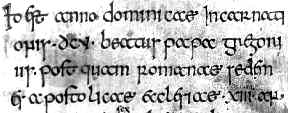|
|
|
|
 |
|
Punctuation |
|
Punctuation
is used to clarify the sense of what is written, and since the development
of the printed book, we have become familiar with a series of punctuation
conventions. These include not only the standard punctuation marks (,
. ; : ? !), but conventions such as word spacing, capital letters at
the beginning of sentences, paragraphing and page formatting. These are particularly
necessary for Anglophones because English is a sloppy language, susceptible
to misinterpretation without it. We also read very fast and silently, and
the division of the text through graphic conventions allows us to absorb large
chunks of text. |
| (See
Bischoff 1990 also
Parkes 1991) |
|
My
resident medievalist assures me that Latin does not require punctuation, as
the grammatical constructions are so precise that the significance cannot
be misunderstood. That is the assertion of someone who reads Latin very accurately,
but perhaps slowly, and who knows it as a written language. The different
forms of punctuation used in the middle ages were graphic clues as to how
the text was to be read. |
|
|
Segment
of a manuscript of Virgil's Aeneid from the Library of St Gall (Cod.1394,p.12).
The manuscript leaves were found doing duty as book covers. |
|
Some
very early manuscripts
almost totally lack punctuation. In majuscule
scripts there
is no distinguishing feature of the letter at the beginning of a sentence.
The words may run continuously without breaks and there may be no punctuation
marks employed. |
 |
|
A
line from a 5th or 6th century copy of Virgil (Rome, Biblioteca Vaticana,
Vat. Lat. 3867) . |
|
Sometimes
in early manuscripts written in square
capitals or rustic
capitals, a dot was placed between each word, as was also done on
carved inscriptions. This reads;
COR(YDON) O CRUDELIS ALEXI NIHIL MEA CARMINA CURAS which
is a question, but there is no question mark to indicate it. |
|
These
texts were essentially designed for reading aloud, and phrasing could
be indicated by leaving spaces of variable size between words at strategic
places, or by the number of words to the line. The spaces represented
points for pausing in oral delivery rather than indicating the grammatical
construction of the text. Grammarians of ancient times had specified a
simple set of punctuation marks for pauses of various length; low point,
medial point and high point which more or less correspond to comma, colon
and full stop. |
 |
This
is a sample from the writings of St Hilarius of Poitiers, dating from 509-10
AD (Rome, Archivio di S. Pietro, D.182. |
|
Continuous
writing, largely unpunctuated, also appears in minuscule
scripts of the very early medieval period. The above example is half
uncial. With the eye of faith, there appears to be the odd small space
between some words, but many others run together in a continuous stream. |
|
The
presumption is that reading is a slow and linear process, probably carried
out aloud, with the eyes tracking steadily left to right along each line
in synchronisation with the utterance of each word. It does not seem at
all probable that a reader could flip through pages quickly for sense.
Many texts, such as the Bible
or Virgil for that matter, may have been well known to the reader and
memory may have played a large part in the reading process. While commentaries
like that of St Hilarius of Poitiers might not seem great candidates for
having been memorised, books of any sort were rare commodities at this
early date and probably scanned repeatedly. We remember less because we
read too much. |
 |
A
9th century copy of Bede's Historia Ecclesiastica (British Library, Cotton
Tiberius C II, f.34) . By permission of the Brtish Library. |
|
Early
Irish and Anglo-Saxon scribes
are credited with the introduction of consistent word spacing as a component
of insular
minuscule scripts. At this remote end of Europe, Latin was being learned
from grammar books rather than from oral culture and the spacing was based
on grammatical units, ie. words, rather than forms of oral presentation.
Note that in the above example, in which the script has features of insular half uncial and insular minuscule, while the words are carefully spaced, they
run over from line to line, as in incarnationis at the end of the first line, or gregorius in the second. The lines are not guides to oral reading. Note also that
the name papa gregorius does not get capital
letters. The capitalisation of proper nouns, or names, seems to be pretty
inconsistent throughout the medieval period. |
|
With
the use of capital letters at the beginnings of sentences written in minuscule
script, enlarged capitals at the beginnings of paragraphs, and the introduction
of forms of punctuation marks, we are getting a more familiar concept of writing,
even though the letter forms and punctuation marks are somewhat different
to those we use today. You can imagine sitting down to a good read of the
volume of Bede shown above without your eyeballs popping out of your head,
as might happen with the examples of Virgil or St Hilarius given further above. |
|
continued
 |
 What
is Paleography? What
is Paleography? |
|
 |
 |
 |
 |


